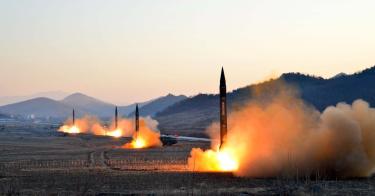A new United Nations report concluding that North Korea can now miniaturize its nuclear weapons sufficiently to put them on missiles has raised a media furor. But the United States has held that assessment since at least 2015. Washington and its allies also judged that the nuclear warheads not only fit on large intercontinental-range ballistic missiles (ICBMs) but also on shorter-range missiles that can target South Korea and Japan.
Successful ICBM tests in 2017 indicate Pyongyang has the ability to reach all of the continental United States with a nuclear weapon.
According to the new U.N. report, North Korea has “probably developed miniaturized nuclear devices to fit into the warheads of its ballistic missiles.” The U.N. Panel of Experts assessed that North Korea is continuing production of nuclear weapons and the regime’s six nuclear tests, conducted from 2006 to 2017, helped it develop miniaturized nuclear devices. One unidentified panel member added that North Korea “may seek to further develop miniaturization in order to allow incorporation of technological improvements such as penetration aid packages or, potentially, to develop multiple warhead systems.”
U.N. Panel of Expert reports suffer from being the least common denominator of agreement among participating countries. China and Russia habitually downplay North Korean capabilities, as well as Pyongyang’s violations of U.N. resolutions. The fact that Beijing and Moscow, usually obstructionist in calling out Pyongyang, are willing to agree to the report’s conclusion suggests the evidence is indisputable.
None of this is news, however, to the United States and allies South Korea and Japan. They have long assessed that North Korea has developed nuclear weapons small enough to fit atop short-, mid-, and long-range missiles. Since at least 2015, U.S. officials, including four-star commanders, have publicly stated that North Korea can delivery miniaturized nuclear weapons via missiles.
In 2015, Admiral William Gortney, commander of U.S. Northern Command and NORAD, commented, “I agree with the intelligence community that we assess that they have the ability, they have the weapons, and they have the ability to miniaturize those weapons, and they have the ability to put them on rockets that can range the homeland.” That same year, General Curtis Scaparrotti, commander of U.S. Forces Korea, and Admiral Cecil Haney, commander of U.S. Strategic Command, also testified that they believed North Korea has already miniaturized at least some of its nuclear weapons.
In 2016, Director of National Intelligence James Clapper publicly stated that the intelligence community concluded years earlier that North Korea had the capability to reach parts of the United States with nuclear weapons. The U.S. intelligence community concluded in 2017 that that North Korea had produced 30-60 warheads and can create fissile material for seven to 12 warheads per year.
South Korea assessed that North Korea was able to produce nuclear warheads for the Scud and No Dong missiles, which puts U.S. bases in South Korea and Japan under threat. South Korea media reported in 2017 that Seoul had reached that conclusion in 2014, but deliberately downplayed that capability in public. A South Korean official told the Joongang Ilbo that “the international community, including South Korea, Japan and the United States, had a tacit agreement that it would not recognize the North’s nuclear weapons.”
After assuming power, North Korean leader Kim Jong Un accelerated nuclear and missile testing and oversaw an expansive diversification of North Korea’s arsenal. Pyongyang has successfully tested a hydrogen (thermonuclear) weapon at least 10 times as powerful as the Hiroshima and Nagasaki bombs; expanded and refined manufacturing facilities for fissile material, nuclear weapons, missiles, mobile missile launchers, and reentry vehicles; created a new generation of more advanced, accurate, and survivable missiles for all ranges; and simulated nuclear airburst attacks over South Korea and Japan.
North Korea’s continually advancing proficiencies suggest additional and more worrisome evolutions in its nuclear doctrine. Pyongyang may be on the path to developing capabilities that go beyond deterrence to a viable offensive warfighting strategy. In a few years, North Korea could have 100-200 nuclear warheads, dozens of mobile ICBMs, and hundreds of improved, survivable short-, medium-, and intermediate-range missiles, as well as submarine-launched missiles.
It is unclear how the United States will respond to the U.N. report. In 2017, the Trump administration vowed it would not allow Pyongyang to complete development of the ability to attack the United States with nuclear weapons and considered a preventive attack on North Korea. Since then, however, President Donald Trump has met with Kim Jong Un on three occasions and declared that the North Korean leader is “denuking the whole place.”
However, the meetings between Trump and Kim failed to break the logjam on denuclearization. Kim has shown himself to be no more willing than his predecessors to abandon North Korea’s nuclear weapons. Trump’s top-down approach of summit diplomacy has not been any more effective than previous efforts to curtail Pyongyang’s nuclear ambitions. Moreover, there has been a cost to his approach. The Trump administration has undercut all three pillars of its “maximum pressure” policy, namely sanctions pressure, military deterrence, and diplomatic isolation.
This piece originally appeared in The Diplomat



